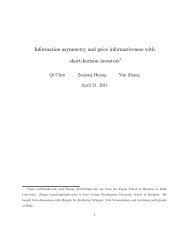Does Enforcement of Intellectual Property Rights Matter in China ...
Does Enforcement of Intellectual Property Rights Matter in China ...
Does Enforcement of Intellectual Property Rights Matter in China ...
You also want an ePaper? Increase the reach of your titles
YUMPU automatically turns print PDFs into web optimized ePapers that Google loves.
when the roles <strong>of</strong> formal f<strong>in</strong>anc<strong>in</strong>g channels are relatively small and narrow (very few large banks)<br />
or virtually nonexistent (a lack <strong>of</strong> corporate bond market)?<br />
Fill<strong>in</strong>g the f<strong>in</strong>anc<strong>in</strong>g gap are trade credit and various <strong>in</strong>formal sources <strong>of</strong> f<strong>in</strong>anc<strong>in</strong>g. Some<br />
examples <strong>of</strong> <strong>in</strong>formal f<strong>in</strong>anc<strong>in</strong>g <strong>in</strong>clude fund<strong>in</strong>g from friends, family, and community, rotat<strong>in</strong>g<br />
sav<strong>in</strong>gs groups, underground f<strong>in</strong>ancial <strong>in</strong>stitutions, and <strong>in</strong>ter-corporate lend<strong>in</strong>g. On one hand, these<br />
<strong>in</strong>formal sources lack legally enforceable means to possess borrowers’ assets as security, thus their<br />
pay<strong>of</strong>f depends critically on the borrowers’ ability to generate cash flows. Poor enforcement <strong>of</strong> IP<br />
rights can <strong>in</strong>crease the probability and magnitude <strong>of</strong> appropriation by the borrowers’ competitors,<br />
result<strong>in</strong>g <strong>in</strong> reduced expected cash flows. On the other hand, when the borrowers disclose<br />
confidential <strong>in</strong>formation to the <strong>in</strong>formal lenders, these lenders may divulge the <strong>in</strong>formation to a third<br />
party <strong>in</strong>clud<strong>in</strong>g other competitors they have f<strong>in</strong>anced (similar to the venture capital situation<br />
modeled by Ueda, 2004).<br />
Firms <strong>in</strong> prov<strong>in</strong>ces with poor IP rights enforcement are therefore<br />
discouraged to seek f<strong>in</strong>anc<strong>in</strong>g from <strong>in</strong>formal lenders. These considerations, taken together, suggest<br />
that there is a positive relationship between IP rights enforcement and firms’ f<strong>in</strong>anc<strong>in</strong>g from<br />
<strong>in</strong>formal sources (Hypothesis 2).<br />
2.5 IP rights enforcement, R&D <strong>in</strong>put, and R&D output<br />
Better IP rights enforcement raises the expected pay<strong>of</strong>f from <strong>in</strong>vest<strong>in</strong>g <strong>in</strong> R&D. Thus, we<br />
hypothesize that high tech firms <strong>in</strong> the prov<strong>in</strong>ces with better IP rights enforcement <strong>in</strong>vest more funds<br />
<strong>in</strong> R&D (Hypothesis 3). Firms <strong>in</strong> prov<strong>in</strong>ces with better IP rights enforcement receive greater<br />
protection from patent <strong>in</strong>fr<strong>in</strong>gement, therefore they are more likely to seek patent generation,<br />
registration, and application. Thus we expect better IP rights enforcement <strong>in</strong>creases the number <strong>of</strong><br />
patents generated by firms (Hypothesis 4A). Poor IP rights enforcement makes steal<strong>in</strong>g <strong>of</strong><br />
11



